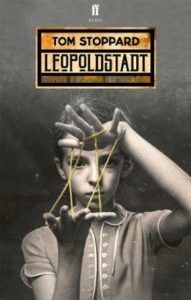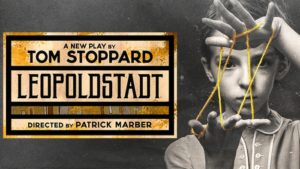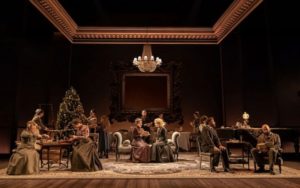The Mourners’ Kaddish
by Mika Provata-CarloneSometimes it is very hard to put words to experiences. In Adorno’s much used (and misused) own words, “there can be no poetry after Auschwitz”; the human soul and mind can conceive of no recreation of experience, no seamless relating to, or of, life through words alone, once the humanity of meaning has been so viciously aggressed and perhaps lost. Tom Stoppard’s new, and, as he affirms, last play, Leopoldstadt, currently at Wyndham’s Theatre, seeks to find the words, the silences, the screams of reason or the irrational, to articulate the experiences of one Jewish family, the Merz-Jakobowiczes, one Austrian city, Vienna, one people, the Jews of Europe, one sociohistorical phenomenon, antisemitism, one historical horror, the Holocaust. In seeking to give expression to such presumed singularities, Stoppard gives expression to the wholeness and totality of our psychosynthesis as a species, our collective psyche, the trajectory of humankind through time. He seeks to restore the presence of absence, to decipher the palimpsest of multiple erasures. And for this total experience, one word applies: relentlessness.
Tom (Tomáš/Tomik) Straussler Stoppard’s Leopoldstadt is unflinchingly relentless. It is a relentless plea to our conscience and consciousness; a relentless probing of our humanity or lack of it; an equally relentless foray into remembrance and the politics of oblivion, guilt and innocence, horrendous crime and eschewed expiation. It is a relentless reminder of our fragility and brutality, our innocence and darker instincts, a relentless exposition on the condition of apartness and belonging. Above all it is a relentless questioning and affirmation.
Consisting of several crescendoed themes and phrases from Stoppard’s corpus, Leopoldstadt is relentlessly epic in scope, ambition and proportions.”
Leopolsdstadt boasts a very tightly composed script – even by Stoppard’s standards. It consists of several crescendoed themes and phrases from his corpus until now, such as the juxtaposition between historical forces and individual lives; logic and emotion; the omnipotence of language and the precariousness of meaning; the density of human connections and the pervading solitude and isolation of our society; public personas and private persons; memory and forgetting; belonging and disappearing. With no fewer than 41 actors (26 adults and a formidable troupe of 15 children), monumental set pieces by Richard Hudson that possess an organic thespian quality of their own, as well as an attention to detail that is almost distracting, from Sachertorte delights to authentic music record sleeves and journals, to the centrepiece carpet that shrinks and greyscales in tandem with the characters’ fates, before it disappears altogether in the final scene, rolled up darkly in the background, and costumes by Brigitte Reiffenstuel, whose metamorphic semiotic qualities are a veritable triumph, Leopoldstadt is relentlessly epic in scope, ambition and proportions.
It begins with a glorious slideshow of vignettes conjuring up the genealogical tree that is at the centre of the story, the conceit of the play. From this family tree, the curtain opens up to the family’s first Jewish Christmas tree, complete with a Star of David on its summit, as the discussion frolics between intermarriages between Jews and Gentiles, and the idea of a Jewish state in Madagascar. Stoppard has always had a mordant instinct for the power of irony to shock and to reveal, and here he spares no one. Already from this doom-filled beginning (the tragic irony of our meta-knowledge is a key agent of the action), the question is one of Echtheit: truth, authenticity, reality itself. The focus here is true Jews (Shtetl, or acculturated Westerners?), true Christians (worthy of agape, or drunk on the power of hate?), true humanity. How does one belong to oneself? To one’s tradition, race, family, fellow humanity? Nostalgia and razor-sharp criticism are evenly balanced, even if there are, at times, somewhat facile clichés that slip through the otherwise formidable, brilliant dialogue. With a Stoppard waiting in the wings to witness the effect of this play of plays on the audience, on believers and doubters, despairing minds and cynics alike, and a Stoppard on the stage, tantalisingly wise and whimsical in turns, the sense of magisterial spectacle is surely guaranteed.
A history of Vienna, as a multifaceted composite of infinite variables that produce a mathematical formula always precariously balanced on the very edge of harmony, provides the canvas for drawing up a tableau of attractions and contradictions. Vienna flourished thanks to the musicians, philosophers, architects, writers, artists, academics, journalists, patriots, industrialists and financiers “of Jewish descent”, who gave it its vibrancy and uniqueness, its global lustre and strength, its tonality of eccentricity and inalienable centrality. It also grew in power on the strength of its antisemitism and xenophobia, its scheming politics, its Metternichs and secret agents, its imperialistic authoritarianism, its ghettos, and its edicts of eviction or conditional tolerance. Its uncanny talent to appear as the victim, when it had longed to embrace the perpetrator. As one character says sarcastically towards the end, was Austria Hitler’s ally, or his first victim? At the very heart of Vienna (as Bezirk No. 2) stands the historical Leopoldstadt, the area where the Jews sought to settle after they were banned from living in central Vienna proper. It is a ghetto, a Gesera, and a haven, with a caustic ironic twist embedded in its name: originally called Unterer Werd, it would receive its later designation following Leopold I’s vituperative expulsion of the Jews in the mid-17th century. Thus cleansed, the area was renamed Leopoldstadt, a church to St Leopold taking over the space of the former synagogue. The Jews would return, the area would prosper, become an emblem of their presence and prominence in the city. The Anschluss would empty Vienna of its Jews. Only one synagogue would survive Kristallnacht, because it was too integrated into the surrounding buildings. Following the capitulation of Germany, Leopoldstadt would be relegated to the Soviet Zone. Harry Lime would hide there.
Part of Stoppard’s agenda is to expose us to our own self-inflicted blindness… In their staggeringly poignant and affecting despair to belong, the Jews of Vienna ignored willingly, complicitly, all the signs.”
The tension between Vienna’s good and evil ought to have acted as a survey map of things as they were, things as they truly are, things as they were about to become. Part of Stoppard’s agenda in his own Leopoldstadt is to expose us to our own self-inflicted blindness, the illusory quality of our insights. In their staggeringly poignant and affecting despair to belong, the Jews of Vienna ignored willingly, complicitly, all the signs. The paterfamilias of the Merz-Jakobowicz clan, Hermann Merz (Adrian Scarborough) is superb in laying bare this duality and schism, as is the Wittgensteinian mathematician Ludwig Jakobowicz (Ed Stoppard). Between the former’s social ambition and the latter’s acrobatic abstractions lies the gulf of misguided gullibility, conscious acculturation, assimilation and dissimulation (or even betrayal), and the warping personal determination that would render the forecasting of the most atrocious tragedy practically impossible.

Ed Stoppard (Ludwig), Alexis Zegerman (Eva), Faye Castelow (Gretl) and Adrian Scarborough (Hermann) in Leopoldstadt at Wyndham’s Theatre © Marc Brenner
To the suggestion that the power of Jewish money is ephemeral and wobbly at best, Hermann professes pragmatic scepticism; to Theodor Herzl’s dream of a Jewish state in Israel, the answer is complacent ratiocentrism: one should not forget it was antisemites who welcomed Herzl’s idea as a perfect way of shipping off the Jews away from Europe; and besides, Hermann adds, assimilation means having a territory (Austria), as a merchant he is happy to melt into the background in order to “carry on being a Jew without insult.” For the intellectual Ludwig (a typically uber-logician Stoppard anti-hero), the answer lies in numbers, in “finding the music in the untuned tonality of numbers” and in identifying true mathematical genius. The question “can you add all the numbers from 1 to 10 (or from 1 to 20)?” reveals the complexity of the human condition: answering 55 or 210 provides evidence of decent number-bond skills, but misses the point, namely the theory of arithmetic progression, of the need to perceive the patterns and connections, just as the observation and explaining away of single episodes of inhumanity as exceptional aberrations, misses the point of Arendt’s so misunderstood, yet so tragically wise doctrine of the banality of evil. The anxiety to belong somewhere, especially elsewhere, at all costs, is a wrenching cri de cœur in the play, as is the Jewish matriarch’s reprimand that the goyim would have given an eye for what assimilated Jews throw away so willingly: family. “The rational is at the mercy of the irrational,” we are told time and time again. As Freud pointed out, “Barbarians will not be eradicated by culture” and in Vienna then, as today, sadly, such barbarians are ante portas relentlessly, and in full force.
As the play progresses through highly stylised scenes marking points of conversion, turning points, and points of no return, another figure emerges, again serving to hone the concepts of connections, disjunctions, oneness and sameness: the cat’s cradle game, both as a snapshot of an innocent childhood now lost, and of the formidable simplicity and genius of the human mind.
Leopoldstadt is a terrifically personal play, deeply autobiographical, for all its transpositions, translocations, translations and transitions.”
As a symbol of the fabric of humanity, but also of the ephemerality of our human trajectories, of the terrible facility of erasures, of vanishings and exterminations, the cat’s cradle game is harrowingly powerful. Yet it is also a marker of what is at the heart of Stoppard’s play on a different level: that we are each of us an everyman, that our personal narrative is the distillation and culmination of many stories. Leopoldstadt is a terrifically personal play, deeply autobiographical, for all its transpositions, translocations, translations and transitions. There is a deliberate saturation of historical intrusions or inclusions that accentuate this ineffable plexus that we are: from Klimt, Herzl, or a Freud pilloried for comfortably leaving Vienna before all hell broke loose, to Wittgensteins Ludwig but also Pauli (in the figure of Hermann’s son Jacob), Stefan Zweig, Arthur Schnitzler, the Vienna Rothschild family, Joseph Unger, Carl König, Arnold Schönberg, Gustav Mahler, Ella Baumfeld Briggs, Paul Engelmann, Maria Altmann and Adèle Bloch-Bauer, referenced in several of the Merz’s biographical details, and in the portrait of Gretl Merz (which itself echoes the newly recovered Portrait of a Lady and its striking green background), as well as the many anonymous shadows of Leopoldstadt and of the Viennese cafes and boulevards. We cannot live in separation from either the living or the dead, and the Becks and the Strausslers, to whom Stoppard owes his life, are both distinct and indistinct from the Merzes and the Jakobowiczes. The same “two distincts, division none” principle applies to everyone who witnesses (not simply watches) Leopoldstadt on the stage.

Ramsey Robertson (Young Jacob) and Faye Castelow (Gretl) in Leopoldstadt at Wyndham’s Theatre © Marc Brenner
The cat’s cradle is also a symbol of the illusory quality of human logic, its capacity to either produce monsters in its dreams, or fantastical labyrinths of reality in its relentless wakefulness. It stands for the inherent naivety, or even hubris, that belies the assumption that the human mind, mere omnipotent logic alone, can decipher both the mysteries of nature and the forces of society. To the cat’s cradle Stoppard adds, yet again, the need for compassion, for the sharing of both joy and pain, the yearning for a simple, unmitigated, unembarrassed humanity.
In its overarching scheme, the cat’s cradle motif is also a chillingly haunting foil for the Nazis’ spiderweb of death closing in on Jewish Vienna (on humanity everywhere). It is elastic and chameleonic enough to slink through the victory of the Allies, the capitulation and perfunctory denazification of Germany, the Nuremberg Trials, remorphing into something other, that is always the same, in our own world today: it creeps up in our relationship to history, memory, truth. In the twisted hands of contemporary crooked minds, the cat’s cradle becomes a game of ‘now you see it, now you don’t’, allowing history revisionists and Holocaust deniers to claim that mayhap, it all never even happened at all.
Ultimately (and this is perhaps the meaning of the play’s stark ending), the agonising questions in Stoppard’s mind, and in his story of so many stories, are memory and identity, the very value of knowing, of connecting, of understanding, of relating. As tragedy culminates, and as a deeply unsettling vacuum seems to prevail, there is almost a tragic competition about trauma and suffering that will not fail to catalyse the audience’s own sentiments and private experiences. Where can one find the lives (or deaths) that have gone unrecorded? Who owns, guards, really recognises memory? What is our duty, debt, vital link to remembrance? Can humanity live without it? What is true memory? What false? Repressed? Reconstructed? How much is enough memory? How much too little? How much too much, if there is such a thing?
Under Patrick Marber’s direction, Leopoldstadt is a tour de force, even with its inevitable quibbles and weaker points. Its relentlessness is a litmus test to our own current state of perilous confusion, obfuscation, veneration of the superhuman clarity afforded by yet another age of reason and technology, of the cult of perfection and power, of cat’s cradles of hyper-connectivity, without real human connectedness. “Today’s modern is tomorrow’s nostalgia”, one of the many memorable one-liners in the play, has a particularly sinister ring for us, or should do: lest we forget how to be human, we must remember. In order to remember, we must understand. In order to understand, we must connect. Connect the mind to the heart, humankind to its own humanity, man and woman to fellow woman and man, present to past, as well as to the future.
 Tom Stoppard’s plays include Rosencrantz and Guildenstern Are Dead, Jumpers, New Found Land, Travesties, Night and Day, The Real Thing, Hapgood, Arcadia, The Invention of Love and The Hard Problem. He co-wrote the screenplays for Brazil, The Russia House and Shakespeare in Love, and has received an Academy Award and four Tony Awards. He has also written extensively for radio and TV. Leopoldstadt continues at Wyndham’s Theatre to Saturday 13 June.
Tom Stoppard’s plays include Rosencrantz and Guildenstern Are Dead, Jumpers, New Found Land, Travesties, Night and Day, The Real Thing, Hapgood, Arcadia, The Invention of Love and The Hard Problem. He co-wrote the screenplays for Brazil, The Russia House and Shakespeare in Love, and has received an Academy Award and four Tony Awards. He has also written extensively for radio and TV. Leopoldstadt continues at Wyndham’s Theatre to Saturday 13 June.
More info
@LeopoldstadtLDN
The playscript is published by Faber & Faber.
Read more
Mika Provata-Carlone is an independent scholar, translator, editor and illustrator, and a contributing editor to Bookanista. She has a doctorate from Princeton University and lives and works in London.



